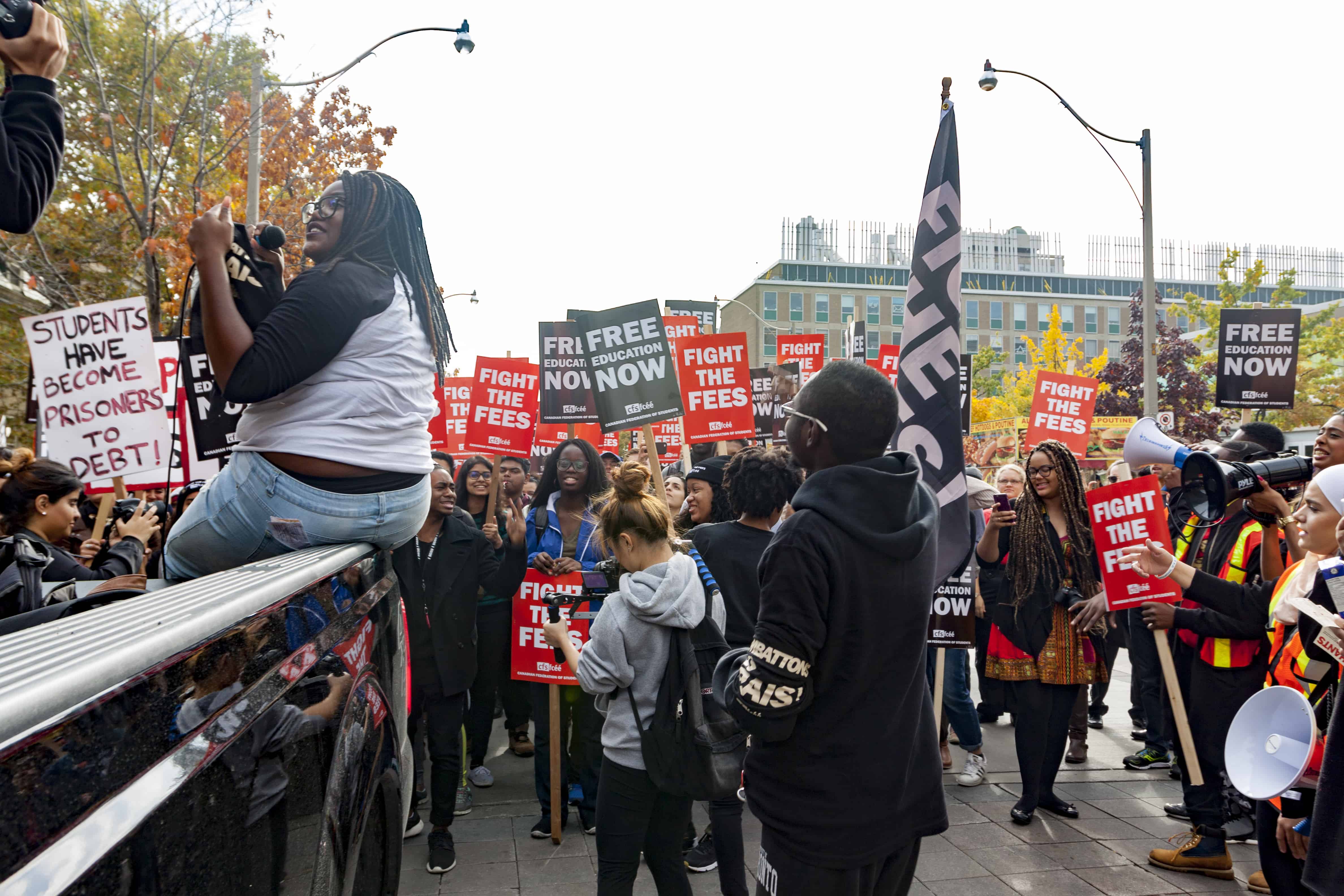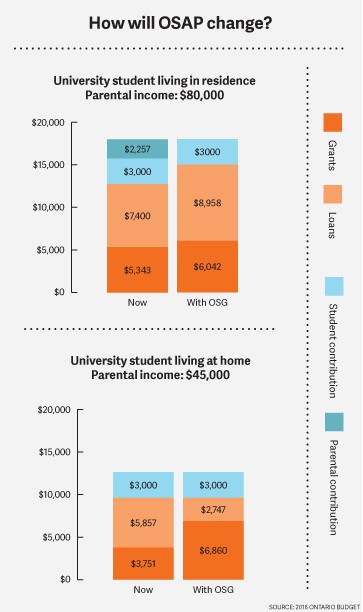Earlier this month, hundreds of students participated in the Canadian Federation of Students’ (CFS) Day of Action and its Fight the Fees! campaign, which called for free tuition. Next year the new Ontario Student Grant (OSG) will be implemented; its announcement was criticized by some for the apparent incompleteness of its promise of free tuition for “thousands of low- and middle-income students.”
The conversation is not over, and in light of both the ongoing governmental reforms and continued activism for free post-secondary education, The Varsity asks: how feasible is free tuition?
A matter of national context
Andre Fast is one of the founders of the Free Tuition Coalition at U of T, a group that advocates for more government funding to reduce and eliminate tuition fees. He is also the Co-Chair of the U of T New Democrats and a former University of Toronto Students’ Union (UTSU) executive candidate, who ran on a platform that included advocating for free tuition.
Fast pointed out that tuition is free in many European countries and goes hand-in-hand with positive social outcomes: “Countries that make significant investments in education have less inequality and more upwards social mobility. Free tuition is feasible and has been implemented in many countries including France, Germany, Denmark, Norway and Finland. We can afford to have free tuition in Canada if we make it a priority.”
Dean of OISE Glen A. Jones, speaking to The Varsity in his capacity as Professor of Higher Education and the Ontario Research Chair in Postsecondary Education Policy and Measurement, stresses the importance of understanding when and where free tuition is possible in a comparative context.
According to Jones, free tuition alone cannot surmount inequality, which is a broad social phenomenon and only really tenably exists in countries with an already narrow income gap.
“If you’re in the Nordic region, for example, then tuition is generally free, but the notion is that salary structures are relatively flat. So being a carpenter or being a doctor or being a professor, the differences in salary structure are not great, and therefore the notion of providing free tuition to encourage folks to continue on is sort of built in to the social-democratic ethos of the environment. That’s never been the case with us — we have a huge difference between the wealthy and the poor,” Jones says.
Should tuition be free?
Jones doesn’t believe tuition should be free across the board: “I think that there is a question about what the magnitude should be. If I look at countries that have free tuition, they generally have lower participation rates than we do, or they have a different sense of social equity than our jurisdiction does.”
Jones continues, “I think that post-secondary education is extremely important. Everyone should have that right to attend and… I think it’s about citizenship, it’s about essentially having an educated population, and there are so many good things attached to having post-secondary education.”
The UTSU had been critical of the CFS National Day of Action and the Fight the Fees! campaign for being too vague and not addressing the higher tuition that professional faculty student pay and the looming expiry of tuition cap increases. Mathias Memmel, who is the union’s Vice-President Internal & Services, argues that free tuition is not necessarily a progressive policy.
“My concern with ‘free tuition’ is that it’s not as progressive as it sounds, and would primarily benefit students who are already better off,” Memmel tells The Varsity. “Any money that we spend on the tuition of high-income students is money that we don’t spend on the tuition low-income students and that, frankly, is not right and is not progressive.”
Ontario Student Grant
The 2017–2018 school year will see the rollout of the OSG. The grant is an amalgamation of a number of distinct loans, grants, and tax credits that fall under the Ontario Student Assistance Program (OSAP). It will cover the full cost of tuition — based on the average arts and science tuition — for students who come from households with an income of $50,000 or less, and over 50 per cent of families with household incomes of $83,000 or less will receive grants in excess of tuition.
Fast thinks the tuition grant is a step in the right direction, but that it doesn’t go far enough. “It re-allocates funds to better assist students from low income families. But the grant will not cover the full cost of education for many students, and it does not provide any new funding. The grant does not help students graduating this year who will have to pay back their debt plus the interest,” he said.
Jones says that the grants are good because they shift the conversation from purely one of free tuition to one of access to holistic financial aid: “Most of this conversation is about access, to arrange the system in such a way that individuals who need that financial support have access to it, and tuition is a small component of that, as you know.”
Jones thinks the grants are “going to be a huge improvement when they’re fully implemented. It’s a good policy in terms of access, because it essentially means you will know what the real price is, not just the sticker price.”
There is a caveat, however, that Jones introduces when discussing the impact of the OSG — it does not necessarily mean improved access for those who might not usually expect to attend post-secondary institutions. “I think if you get preoccupied with tuition, you lose the broader situation. And the broader situation is about the differences in family backgrounds, it’s about the reality of providing student financial assistance that helps those who need it,” he says.
Is tuition and money everything?
Fast and Jones agree that money and tuition should not be nebulous in discussions on accessibility of education.
“Tuition fees should be eliminated because they act as a significant barrier for students across Canada… A post-secondary degree is… equivalent to the value of a high school diploma a generation ago, but unaffordable tuition prevents many students from low income families from attending university,” says Fast.
“Enrolment records show that only 10% of university students are from the lowest income quartile, while 50% are from the wealthiest income quartile. Tuition fees reinforce existing social barriers and disproportionality [sic] impact Indigenous students, racialized students, students with disabilities and queer and trans students who are more likely to have lower incomes,” he continues.
Fast sees education as one of a number of critical barriers to social mobility, while Jones argues that issues of inequality and social mobility themselves are partly barriers to education reform in Canada.
“A very high percentage of individuals from strong, high-quartile family backgrounds are… attending university. Even with all these subsidies, all these arrangements, the population who attends is not representative of the population as a whole. And you’d find almost the exact same situation in countries where they do have free tuition. So free tuition does not somehow level the playing field and change the situation so everybody who is poor goes. In reality, there are other things going on,” Jones says. “To assume that money makes the playing field completely even becomes a little naïve.”
Feasibility of free tuition
The CFS’ three demands in their fight for free tuition calls for: a gradual but total elimination of tuition fees to make post-secondary education universal, student loans to be entirely replaced with student grants, and all existing student loans to be made interest-free.
Jones does not see these demands as feasible: “It is important to realize that there are great variations in these answers that vary by province… I don’t see a situation right now where the various provincial governments will come up with the billions and billions and billions of dollars necessary to move towards free tuition. And some of that is just a political reality.”
Fast remains optimistic that collective action may have an impact: “In most countries where free tuition has been achieved, students organized and advocated collectively … now is the time to reaffirm our belief that education is a public good and continue to fight for free accessible education.”
Jones admits that free tuition does remain a minute possibility. Chuckling about the failure of many to predict the outcome of the 2016 US presidential election, he insists that he “will never say never.”



